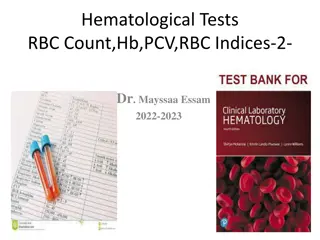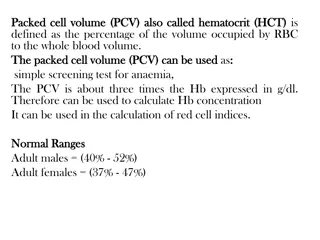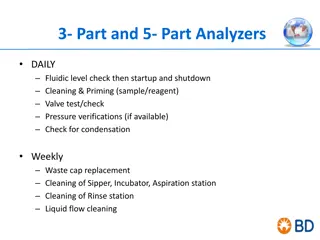Understanding Hemoglobin Tests and Hematocrit in Blood Analysis
A hemoglobin test measures the amount of hemoglobin in the blood, which is essential for oxygen transportation in red blood cells. The test is crucial for diagnosing various health conditions, and visual methods are employed for analysis. Additionally, hematocrit, or red blood cell volume, is anothe
9 views • 23 slides
Hematological Tests RBC Count,Hb,PCV,RBC Indices-2-
Hematological tests play a crucial role in assessing blood health. This guide covers the significance of RBC count, hemoglobin levels, PCV, and RBC indices. It explains the photometric technique for measuring hemoglobin, visual methods for analysis, sample hemoglobin level reference ranges, and insi
3 views • 20 slides
Understanding Blood Cells and Their Functions in the Circulatory System
Blood is comprised of cells and plasma that circulate within the closed circulatory system. The formed elements include erythrocytes, platelets, and leukocytes, each playing vital roles in oxygen transport, defense against infection, and nutrient distribution throughout the body. The hematocrit esti
2 views • 38 slides
Understanding Packed Cell Volume (PCV) and Hematocrit in Blood Testing
Packed cell volume (PCV) is a measure of the percentage of blood volume occupied by red blood cells (RBCs), used to screen for anemia and calculate hemoglobin concentration. Also known as hematocrit (HCT), it falls within specific ranges for adult males and females. The PCV is determined from venous
0 views • 5 slides
Understanding Anticoagulants Used in Hematology Laboratory
Anticoagulants play a crucial role in hematology by preventing blood clotting, allowing separation of blood components, with EDTA being the most commonly used anticoagulant. Proper blood-to-anticoagulant ratio is essential to avoid inaccuracies in results, such as falsely reduced hematocrit or erron
0 views • 10 slides
Understanding Packed Cell Volume (PCV) in Blood Analysis
Packed Cell Volume (PCV), also known as hematocrit, is a crucial parameter in blood analysis that indicates the relative proportion of red blood cells to plasma. It is used for detecting anemia, polycythemia, and assessing red cell indices. The Wintrobe method is commonly employed to measure PCV, in
0 views • 9 slides
Laboratory Equipment Maintenance Guidelines for Daily, Weekly, and Monthly Tasks
Regular maintenance tasks for various laboratory equipment including analyzers, flow cytometer, automated gel electrophoresis, and micro hematocrit. The guidelines cover daily, weekly, and monthly checks, cleanings, replacements, and verifications to ensure proper functioning and accurate results. T
0 views • 7 slides
Understanding Anemia: Causes, Symptoms, and Classification
Anemia is characterized by a reduction in hemoglobin (Hg) concentration, hematocrit (Hct) concentration, or red blood cell (RBC) count. Common symptoms include fatigue, weakness, dizziness, and palpitations. Physical signs may include pallor and tachycardia. Pica, characterized by unusual cravings,
0 views • 23 slides
Understanding Blood Components and Microhaematocrit Procedure in Physiology Lab
Blood is a complex fluid composed of various components like platelets, erythrocytes, and leukocytes suspended in plasma. Microhaematocrit is a technique used to measure hematocrit levels in blood. The process involves collecting blood in a capillary tube, centrifuging it to separate the layers, and
0 views • 14 slides
Understanding Hematocrit (PCV) Test: Importance and Procedure
Hematocrit (PCV) is crucial for assessing anemia or polycythemia. It measures the percentage of blood volume occupied by red blood cells. This test is accurate and simple, providing valuable information for diagnosing various conditions. Normal values, causes of increased or decreased PCV, and the p
0 views • 23 slides









